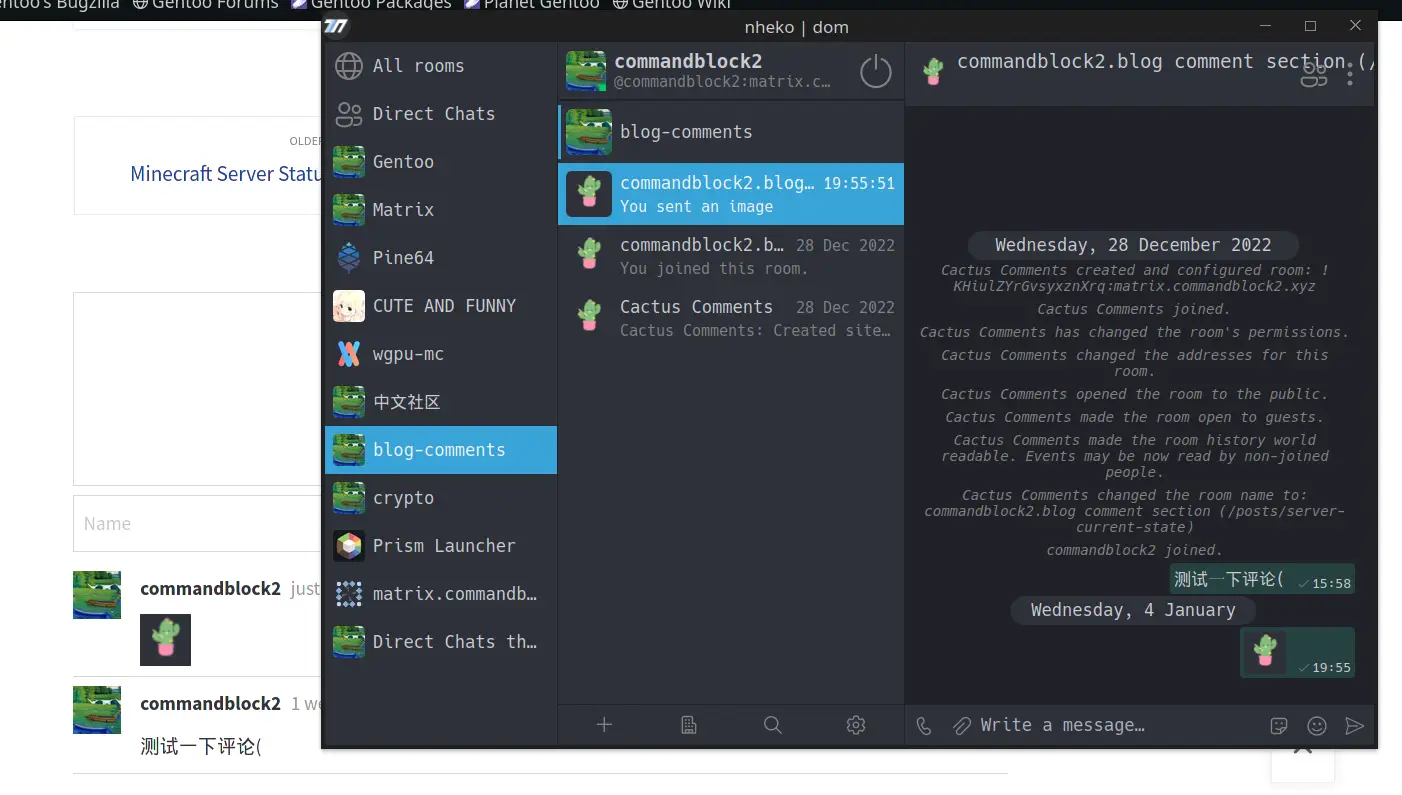如果想要使用matrix支持
直接点login会有告诉你invalid link,但是我并不知道这个锅是谁的,是cactus appservice的还是matrix.to的
Workaround
右键login, copy link
你会拿到一个像这样的 https://matrix.to/#/%23comments_commandblock2.blog_%2Fposts%2Fserver-current-state%3Amatrix.commandblock2.xyz 把 https://matrix.to/#/ 去掉, %23 -> #, %2F -> /, %3A -> : (其实这个操作就是reverse的escape)
最后拿到 #comments_commandblock2.blog_/posts/server-current-state:matrix.commandblock2.xyz 使用任意matrix客户端,加入这个群
在群里发送的信息会被转成评论

架设相关
之前想要加的 cactus comment 终于加到这个blog上了(
在没看文档之前,我还以为可能是个有点小麻烦的事情
但没想到里面直接有写 jekyll 的集成,那可好啊
https://cactus.chat/docs/integrations/jekyll/
最开始试用的时候用的是他们提供的 matrix homeserver,但是我有一个,所以还是要用自己的才舒服
这个用起来还挺简单的,往html里加个
1
2
3
4
5
6
7
8
9
10
11
<div id="comment-section"></div>
<script>
initComments({
node: document.getElementById("comment-section"),
defaultHomeserverUrl: "https://matrix.cactus.chat:8448",
serverName: "cactus.chat",
siteName: "",
commentSectionId: "/posts/comments-now-available/"
})
</script>
<noscript>Please enable JavaScript to view the <a href="https://cactus.chat" rel="nofollow">comments powered by matrix.org.</a></noscript>
差不多网页端就完事了,至于加到什么位置,就取决于你想要在哪显示评论了
啊对了那个initComments需要先fetch他们的script,那个也是开源的,用一个我没听说过的叫elm的语言写的,编译出来的js和css在教程里也会告诉你怎么引用,他们是把这俩东西放在ipfs上的
如果你要换homeserver的话可能得在浏览器上清一下cache或者啥,虽然我也不知道是谁的锅,但是确实可能会代码里换了结果在浏览器里还是旧的homeserver
appservice架设
ppservice是单独的一个服务器(进程),通过http和homeserver进行通讯
官方给的是用docker服务或者是systemd服务,我对docker不大感冒,虽然都是隔离环境(所以理论上除了网络和一些其他的隔离需要的东西),应该没啥性能损失,但是docker里要对镜像做点小改动在升级的时候就会很要命。
至于不用systemd只是因为有openrc,不希望垄断而已
我的服务器上没有systemd但是还是照着systemd的教程来的,clone下repo,然后用keepassxc生成的hs_token和as_token(这俩可以随意生成),这俩算是俩密码吧。
坑爹玩意这个教程里的两个token在两份配置文件里的顺序不一样
大概是官方示例
cactus.yaml,这个是给synapse用的appservice配置文件
1
2
3
4
5
6
7
8
9
10
11
12
13
14
15
16
17
18
19
# A unique, user-defined ID of the application service which will never change.
id: "Cactus Comments"
# Where the cactus-appservice is hosted:
url: "http://cactus:5000"
# Unique tokens used to authenticate requests between our service and the
# homeserver (and the other way). Use the sha256 hashes of something random.
# CHANGE THESE VALUES.
as_token: "a2d7789eedb3c5076af0864f4af7bef77b1f250ac4e454c373c806876e939cca"
hs_token: "b3b05236568ab46f0d98a978936c514eac93d8f90e6d5cd3895b3db5bb8d788b"
# User associated with our service. In this case "@cactusbot:example.com"
sender_localpart: "cactusbot"
namespaces:
aliases:
- exclusive: true
regex: "#comments_.*"
这个是appservice的环境变量,老坑爹玩意,这个hs在上头
1
2
3
4
CACTUS_HS_TOKEN=b3b05236568ab46f0d98a978936c514eac93d8f90e6d5cd3895b3db5bb8d788b
CACTUS_AS_TOKEN=a2d7789eedb3c5076af0864f4af7bef77b1f250ac4e454c373c806876e939cca
CACTUS_HOMESERVER_URL=http://localhost:8008
CACTUS_USER_ID=@cactusbot:example.com
官方给的systemd配置文件
1
2
3
4
5
6
7
8
9
10
11
[Unit]
Description=Cactus Comments appservice: Matrix powered embeddable comment backend
[Service]
Type=simple
ExecStart=/bin/bash -c 'gunicorn -w 4 -b 127.0.0.1:5000 --timeout 500 "app:create_app_from_env()"'
Restart=always
# Adjust this!
EnvironmentFile=/srv/www/cactus-appservice/env/appservice.env
# Adjust this!
WorkingDirectory=/srv/www/cactus-appservice
那我就改改,改成 shell + cron 好了 cactus.sh
1
2
3
4
5
6
7
8
9
10
11
12
13
#!/bin/bash
cd ~/cactus-appservice/
source env/bin/activate
source env.env
SESSION="cactus"
if screen -ls | grep -q $SESSION > /dev/null
then
echo "server already started, no need to start again, script exiting"
exit
fi
screen -S $SESSION -dm gunicorn -w 2 -b 127.0.0.1:5000 --timeout 500 "app:create_app_from_env()"
crontab: */1 * * * * ~/cactus-appservice/cactus.sh 我知道这么做不是合适就是了,但是能用就行
